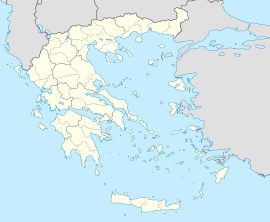Vlachogianni
Vlachogianni
Βλαχογιάννι | |
|---|---|
| Coordinates: 39°44.5′N 22°5.3′E / 39.7417°N 22.0883°E | |
| Country | Greece |
| Administrative region | Thessaly |
| Regional unit | Larissa |
| Municipality | Elassona |
| Municipal unit | Potamia |
| Area | |
| • Community | 33.974 km2 (13.117 sq mi) |
| Elevation | 150 m (490 ft) |
| Population (2021)[1] | |
| • Community | 684 |
| • Density | 20/km2 (52/sq mi) |
| Time zone | UTC+2 (EET) |
| • Summer (DST) | UTC+3 (EEST) |
| Postal code | 401 00 |
| Area code(s) | +30-2492 |
| Vehicle registration | PI |
Vlachogianni (Greek: Βλαχογιάννι, Greek pronunciation: [vlaxo'ʝani]) is a village and a community of the Elassona municipality, in Greece.[2] Before the 2011 local government reform it was a part of the municipality of Potamia, of which it was a municipal district and the seat.[2][3] The community of Vlachogianni covers an area of 33.974 km2.[4]
History
[edit]In the Ottoman tahrir defteri (number 101) of 1521, the settlement is recorded as a village with the name İvlahoyan.[5] In 1531, Vlachogianni is mentioned in an Ottoman bey's will.[3] In the end of the 16th century the main occupation of the people's residents was the cultivation of Cannabis sativa.[3] In the beginning of the 19th century the village became a chiflik of Ali Pasha.[3]
In the early 1900s, Vlachogianni was being used as a winter residence by semi-nomadic Aromanians; they were Farsherots, and Pindeans from certain villages in the region of Grevena. Between 1913 and 1914, there were 268 Aromanians that were wintering in Vlachogianni, out of a total population of 689 residents.[6]
Economy
[edit]The population of Vlachogianni is occupied in animal husbandry and agriculture (mainly tobacco).[3]
Population
[edit]| Year | Pop. | ±% |
|---|---|---|
| 2001[4] | 891 | — |
| 2011[7] | 895 | +0.4% |
| 2021[1] | 684 | −23.6% |
See also
[edit]References
[edit]- ^ a b "Αποτελέσματα Απογραφής Πληθυσμού - Κατοικιών 2021, Μόνιμος Πληθυσμός κατά οικισμό" [Results of the 2021 Population - Housing Census, Permanent population by settlement] (in Greek). Hellenic Statistical Authority. 29 March 2024.
- ^ a b "ΦΕΚ B 1292/2010, Kallikratis reform municipalities" (in Greek). Government Gazette.
- ^ a b c d e Βλαχογιάννι (in Greek). elassona.com.gr. Retrieved 29 November 2014.
- ^ a b "Population & housing census 2001 (incl. area and average elevation)" (PDF) (in Greek). National Statistical Service of Greece.
- ^ Ünal, Uğur; Budak, Mustafa; Bayram, Sabahattin; Yıldıztaş, Mümin (2013). Özkılınç, Ahmet; Coşkun, Ali; Sivridağ, Abdullah (eds.). Osmanlı Yer Adları I: Rumeli Eyaleti (1514–1550) (in Turkish). Ankara: Directorate of State Archives. pp. VII–VIII, 42, 409. ISBN 978-975-19-6238-6. p. 409:
İvlahoyan k., Alasonya n., Alasonya kz., Tırhala l.: TD 101/64
- ^ Koukoudis, Asterios (2001). Οι Ολύμπιοι Βλάχοι και τα Βλαχομογλενά (in Greek). Ekdoseis Zitros. pp. 55, 70, 197–198. ISBN 9789607760517. OCLC 44914571.
Οι Ολύμπιοι Βλάχοι, 1900–1912 [map] [...] Αν μάλιστα αναλογιστούμε πως οι ετήσιες εποχιακές μετακινήσεις των ημινομάδων κτηνοτρόφων, ιδιαίτερα από τα βλαχοχώρια της Βόρειας Πίνδου – Γρεβενών, τους έφερναν κάθε χρόνο στους πρόποδες του Ολύμπου, στα χωριά και τα χειμαδιά της Ελασσόνας και της Ποταμιάς, μπορούμε να κατανοήσουμε αυτή τη συνεχή και αδιάκοπη επαφή. [...] Το 1913–14, μετά την απελευθέρωση, και σύμφωνα με εκθέσεις των κατά τόπους δασκάλων, στην επαρχία Ελασσόνας αναφέρονται παραχειμάζοντες ή μόνιμα εγκατεστημένοι Βλάχοι κάτοικοι στα εξής χωριά. [...] Στο Βλαχογιάννι υπήρχαν 689 κάτοικοι, από αυτούς οι 268 ήταν παραχειμάζοντες Βλάχοι.
- ^ "Απογραφή Πληθυσμού – Κατοικιών 2011. ΜΟΝΙΜΟΣ Πληθυσμός" (in Greek). Hellenic Statistical Authority.
